CURTIS LICENSING
How we created a sustainable licensing program from a 200 year old magazine By Cris Piquinela, Director of Licensing at Curtis Licensing The name The Saturday Evening Post usually conjures images of classic Americana. Idyllic small town images, happy families enjoying the simple and worriless life, the glowing expectant faces of children waiting for Santa on Christmas Eve and of course, there is Norman Rockwell. No other artist has ever been more celebrated for his sentimental, and often humorous portrayals of American life than Rockwell. Whether you grew up reading The Saturday Evening Post or are completely unfamiliar with Norman Rockwell, when presented with the classic illustrations that made the magazine famous, most people feel a clear connection to them. But how do you translate that to a viable, sustainable licensing program? When I joined SEP, the bulk of the licensing agreements were driven by the Norman Rockwell covers. While there were also a good number of licensees that utilized covers by other artists such as J.C. Leyendecker, Stevan Dohanos and John Falter, the offerings were heavily skewed towards Norman Rockwell, and with good reason. The man is a legend when it comes to illustration. His original works are routinely sold at auction for millions of dollars, his covers are recognized all over the world and he has generated images that are often imitated by other artists, such as the iconic
PAGE 42
Freedom From Want image. However, as they say, you can’t put all your eggs in one basket, so in order to grow, we had to expand beyond the classics. One thing that most people don’t realize about SEP is the sheer enormity of our archive. To give some perspective, the first official issue of The Saturday Evening Post was published on August 4, 1821. As reference, James Monroe was the president of the United States at the time and that was the same year that Napoleon died! At the start, SEP was only a 4 page “broadsheet,” but by the early 1900s it had grown into a weekly magazine with over 100 pages of articles, photos, illustrations and cartoons per issue! And that only accounts for 1 magazine within the various publications included under our umbrella, which include Country Gentleman as well as various children’s publications like Jack and Jill, Playmate, Turtle, Child Life and many others. Given the huge popularity of the SEP covers, it seemed only natural to base the beginnings of our licensing program on those images. Among our first merchandise licenses in early 1960’s were prints and greeting cards in the most popular themes. Fast forward to 2009 when I started at SEP, and still the bulk of our licensing business was based on the same classic well-known images. But then two things
happened that radically changed how we did business. At the same time that our licensing division started looking into different materials to generate revenue, our Publisher, Joan SerVaas, began implementing a legacy preservation project for SEP that consisted on scanning every issue of the magazine cover to cover. This massive scanning endeavor was aimed at not only preserving the historical value of the collection, but also eventually offering the archive to consumers digitally. From a licensing perspective, this growing scans collection meant that we could now view various pages on a digital screen simultaneously, rather than physically going through the printed issues page by page looking for materials. In the years since the scanning project began, we have accrued 437,663 pages of content for The Saturday Evening Post and over 300,000 pages from our other magazines, and counting. We are also tagging the various materials which will make our future searches even more efficient and productive. Previously, it would take us days to gather a few images for any given theme…now we can gather a collection in a matter of hours. The ability to quickly view and search for images also further opened our eyes to the multitude of other content that we had at our disposal for our licensing program. Cartoons, children’s stories, poems, articles, the possibil-
TOTAL BRAND LICENSING

















